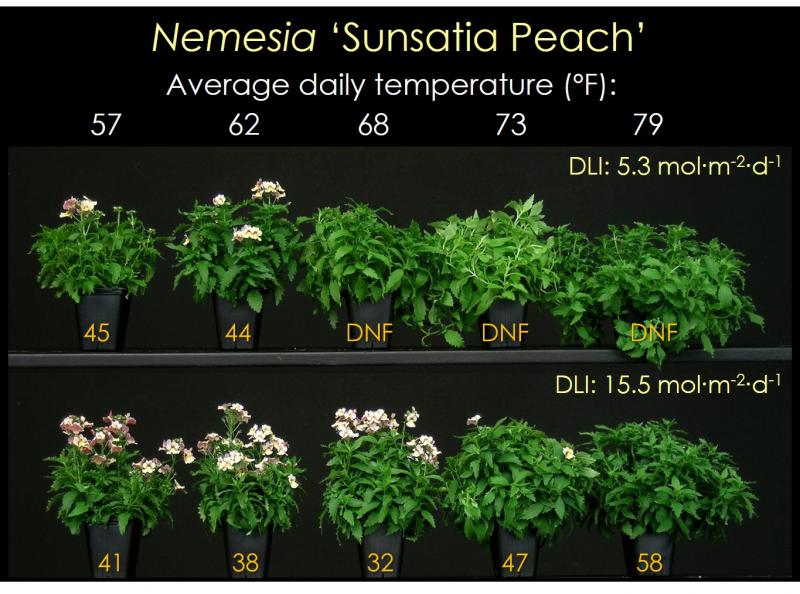Crops with Relatively Low “Optimum” Temperatures
Temperature is the primary factor that controls the rate of plant development. Plants grow progressively faster as the average daily temperature increases. This is only true to a point though — obviously you can’t put plants in an oven to make them grow even faster! Our research group at Michigan State University has studied how temperature regulates flowering time of a wide range of bedding plants and herbaceous perennials — see www.flor.hrt.msu.edu/production-info for crop-specific information.
The optimum temperature can be defined as the average temperature that induces the most rapid flowering. The word “optimum” can be misleading though because it isn’t necessarily the recommended growing temperature. In many situations, especially when light is limiting, crop quality is improved when plants are grown below the optimum temperature.
We determined crop responses to temperature by growing them in either greenhouses or growth chambers with different temperature set points. The optimum temperature of some plants — particularly cold-tolerant crops — was greater than 85¡ F (the highest temperature tested) and so their optimums were usually not identifiable. However, we did identify the optimum temperatures for some crops (Table 1). Other researchers have performed similar studies and those are also reported in the table.
Why is this noteworthy? At temperatures above the optimum, plants experience stress and the rate of development begins to decrease. The result is a flowering delay and the magnitude of that delay increases as temperature increases and duration of exposure increases. Therefore, when possible, avoid prolonged exposure of crops to temperatures above their optimums. These optimum temperatures were usually identified by growing plants at constant day/night temperatures. At least for a chrysanthemum, the night temperature is the critical factor that can delay flowering. In other words, mums can tolerate warm days but warm nights (more than 70¡ F) delay flowering.
Interestingly, there is cultivar variation in optimum temperatures, such as in osteospermum and nemesia. These crops have been bred, in part, to be more temperature tolerant. For example, nemesia ‘Sunsatia Peach’ has a low optimum temperature especially when grown under a low daily light integral (Figure 1). This type of temperature response is great for cool growing and colder climates. In contrast, the optimum temperature of nemesia ‘Poetry White’ was greater than 79¡ F, which is better suited for warmer growing regions.
Table 1. Examples of seed-propagated bedding plants in which the optimum temperature is less than 85¡ F. Although the rate of flowering is fastest at the optimum temperature, higher quality plants are typically produced at lower temperatures.
| Crop and cultivar studied | Optimum temperature (¡F) |
| Angelonia ‘Serena Purple’ |
81 |
| Blue salvia ‘Victoria Blue’ |
82 |
| Browallia ‘Bells Marine’ |
80 |
| Chrysanthemum (many cultivars) |
68-70 |
| Cineraria ‘Cindy Blue’ |
67* |
| Cosmos ‘Cosmic Orange’ |
75 |
| Dahlia (various) |
66-76 |
| Dianthus ‘Super Parfait Raspberry’ |
81 |
| Geranium ‘Sooner Red’ |
83 |
| Impatiens ‘Blitz 3000 Deep Orange’ |
77 |
| Nemesia ‘Sunsatia Peach’ |
63-68 |
| Nemesia ‘Poetry White’ |
>79 |
| Pansy ‘Universal Violet’ |
71 |
| Pentas ‘Graffiti Lavender’ |
82 |
| Petunia ‘Snow Cloud’ |
77 |
| Portulaca ‘Margarita Apricot’ |
75 |
| Snapdragon ‘Montego Orange Bicolor’ |
78 |
| Verbena ‘Quartz XP Waterfall Mix’ |
76 |
| Viola ‘Sorbet Plum Velvet’ |
80 |
|
*Lower temperatures can accelerate flower initiation of cineraria. |
Figure 1. Some cultivars of some crops, such as nemesia, have relatively low “optimum” temperatures, especially when grown under a low daily light integral (DLI). DNF=did not flower.



 Video Library
Video Library 




















